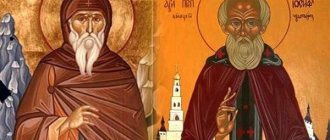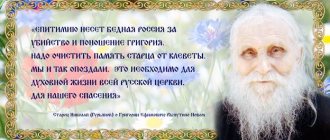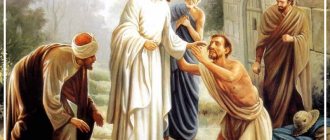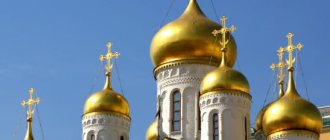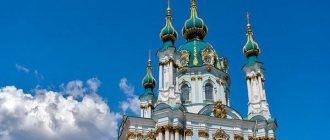Career rise
And how successfully it all started! The boy Vanya from the Kulchytsky gentry family from the Chernihiv region entered the Kiev-Mohyla College, studied there with Metropolitan Stefan (Yavorsky), the future president of the Theological College established by Peter I after the abolition of the patriarchate, immediately renamed the Holy Synod, and the archbishop who later replaced him in this post. Feofan (Prokopovich). By the end of the course, he accepted monasticism with the name Innocent and was personally requested to Moscow for the position of teacher and prefect at the Slavic-Greek-Latin Academy, and from there to St. Petersburg, where at that time the Alexander Nevsky Monastery, the future Lavra, was just founded. There, a young educated monk attracted the attention of the emperor, who decided to send him... to Beijing to open a Russian Orthodox spiritual mission there. And in 1721, Hieromonk Innokenty was ordained a bishop and, accompanied by two hieromonks, a hierodeacon, five choristers and three ministers, was escorted to an unknown country.
It took them almost a year to get to Irkutsk. From there they moved beyond Baikal and stopped in Selenginsk, on the border with China, and there they waited for three years, first for permission to enter China, and having been refused, for further orders of the Synod. There was no money at all. In order not to die of hunger, the missionaries caught fish and hired themselves out to work for local owners. Vladyka Innokenty repaired his worn-out dress himself. And he found consolation in the prayers and services that he performed in the old Selenga Cathedral.
Saint Innocent of Irkutsk
Saint Innocent of Irkutsk
Abstracts:
Who are the saints? You will probably be surprised to hear that the saints were people just like each of us. They experienced the same feelings as us, their souls were visited by both joy and disappointment, not only hope, but also despair, both inspiration and extinction.
The saints became holy because, firstly, they saw their unrighteousness, their distance from God (one should not think that every saint of God was initially a saint). And secondly, they deeply felt that no good could be accomplished without God. They turned to Him with all their souls. They had to fight a lot with evil, and above all in themselves. This is their difference from ordinary heroic personalities. Earth's heroes are trying to change the world through an external struggle for justice. And saints influence the world through its internal transformation, and begin this transformation with themselves.
1. Introduction
When I was born, my parents couldn’t choose a name for me for a long time. Among the list of names was the now rare name “Innocent”. This is what we chose. When I grew up, I often visited Irkutsk churches with my parents. In one of the churches - Znamensky - we more than once venerated the relics of St. Innocent of Irkutsk. Dad told me that he named me after this saint. I began to wonder - what kind of person was this, whose relics are venerated by so many people? What is he famous for? Why does he have such a title? The goal of my work was to obtain answers to these questions.
Goal: to study the life of St. Innocent of Irkutsk.
Objectives: having studied the life of St. Innocent of Irkutsk, answer the questions: how did St. Innocent live; what he became famous for during his lifetime; why do Orthodox people worship his relics; in what way can I be like St. Innocent.
2. Brief life of St. Innocent, Bishop of Irkutsk, miracle worker.
(celebration 9/22 February, 26 November/9 December)
1) Origin and youth.
Saint Innocent, Bishop of Irkutsk, known for his piety and learning, was an educator of the most remote outskirts of the Russian state - Eastern Siberia, and an experienced organizer of church life in the Irkutsk diocese.
He came from a noble family of the Kulchitskys (in the world he bore the name John). The saint was born around 1682. He studied at the Kyiv Theological Academy. In 1706, having completed his course of study, he took monastic vows with the name Innocent and joined the brethren of the Kiev Pechersk Lavra.
In 1710, Hieromonk Innocent was summoned to Moscow to teach at the Moscow Slavic-Greek-Latin Academy. He taught literature, homiletics, moral theology, metaphysics and philosophy. In 1719, among the most educated monks, by decree of Peter I, he was summoned to the Alexander Nevsky Lavra and, as a cathedral hieromonk, was appointed to the ship “Samson”, stationed in Reval (Tallinn). Soon he received a new appointment to the position of chief hieromonk of the fleet in the Finnish city of Abo. As the senior hieromonk of the fleet, he spiritually led all the clergy serving on the ships.
2) Responsible mission.
In 1721, the Holy Synod assigned Innocent to the Russian spiritual mission in Beijing. On April 19, 1721, the Russian missionary, together with several church ministers, left St. Petersburg, and only in March 1722 arrived in Irkutsk. From there we moved further, beyond Baikal, and stopped in Selenginsk, bordering China. Here the mission had to wait for the decision of Beijing officials on the right to enter. In the letter asking for permission to enter, Bishop Innocent was called “Bogdo” - that is, “great”, and among the Chinese such an address was accepted only for the emperor, and therefore it is impossible for two great persons to be in China at the same time. Thus, the matter of sending the saint to China could not be brought to the desired end.
The saint was forced to spend three years in Selenginsk on the border with China, enduring many hardships due to the uncertainty of his position and the disorder of civil administration in Siberia. He repeatedly appealed to the Synod, reporting his plight: “Where can I lay my head and end the rest of my life...? I humbly ask for a gracious decree on what I should do: should I sit in Selenginsk and wait for what I don’t know, or should I go back? And with what? - Without a decree, the cart will not be given. And where? “I wander from yard to yard and from house to house, transiently.”
Without receiving a salary, the saint and his companions lived on the alms of Russian merchants. The only joy for Saint Innocent were the Divine Services in the Selenga Cathedral and in the Church of the Trinity Selenga Monastery. Despite the difficult living conditions, the saint never remained idle: he painted icons, preached the Word of God to the Buryats and Mongols who lived around him, and enlightened them with holy Baptism.
3) Service in Irkutsk.
In February 1725, a decree came from the Synod commanding the saint to leave Selenginsk for Irkutsk, where he settled in the Ascension Monastery. In August 1727, the saint received a decree appointing him ruling bishop of the new Irkutsk diocese. The vastness and sparse population of the diocese, the large number of different nationalities (Buryats, Mongols, Yakuts, etc.) not enlightened by the faith of Christ, impassability and poverty - all this made the archpastoral work of St. Innocent difficult and his life full of hardships. Due to a strange oversight of the Senate, he did not receive a salary for a long time and suffered an extreme lack of funds. In these difficult conditions, the Mongol-Russian school was maintained with the meager funds of the Ascension Monastery. The saint's tireless concerns were directed toward selecting worthy teachers and providing students with the necessary books, clothing, and food.
The saint worked tirelessly to organize the diocese and strengthen its spiritual life, as evidenced by his
numerous sermons, pastoral letters, instructions and prescriptions.
Many miracles happened during the life of St. Innocent.
So, in the spring of 1728, a drought began in the Baikal region. The diocese was threatened with famine due to the shortage of bread, which began back in 1727. With the blessing of the saint, from May in the churches of Irkutsk and the Irkutsk Tithe they began to add a prayer service to each Liturgy for the end of the drought, on Saturdays they sang an akathist to the Mother of God, and on Sundays they served a cathedral prayer service. “Prayers,” said the saint, “must end on Elijah’s day.” On July 20, a storm broke out in Irkutsk with such heavy rain that water stood knee-deep in the streets of the city—the drought ended.
Through the labors of Saint Innocent, the construction of a stone church in the Ascension Monastery began to replace the wooden one, and the borders of the diocese were expanded to include not only the Selenginsky, but also the Yakut and Ilimsky districts. In the diocese of the saint there were 33 churches and 4 monasteries.
Commanding the monks to observe the monastic rule, the saint himself strictly followed it. He loved to retire to prayer. At night the saint read the works of the holy fathers and often, at night, left his cell, went to the main church of the Ascension monastery and prayed at it from all four sides. In his cell life the saint was simple and took part in field work.
Not being distinguished by good health, under the influence of the harsh climate and adversity, Saint Innocent departed early to the Lord. He reposed on the morning of November 27, 1731.
3. Revealed miracles and glorification
The body of the saint, buried under the altar of the Tikhvin Church in the Ascension Monastery, did not remain hidden for long. Around 1765, on the occasion of the reconstruction of the temple, the tomb with the relics of the saint was opened. The coffin was completely intact, even the velvet with which it was upholstered was not damaged by dampness. The holy relics turned out to be completely incorruptible and emitted a fragrance.
In 1800, Emperor Paul I was informed about the incorruptibility of the relics of Saint Innocent and about the miracles that flowed from the relics of the saint of God. In the same year, in accordance with the wishes of the sovereign, the Holy Synod ordered an accurate inquiry into this matter. Rigorous research by clergy and laymen has confirmed the report. A report was made to the Holy Synod, in which they expressed their opinion: “In order to rank this first Irkutsk Bishop Innocent as a saint, revered and glorified by the Church; his body is incorruptible, like true relics and worthy of being declared and opened for public veneration.” Two years later, the Holy Synod demanded from the Irkutsk bishop new information regarding the recognition of the holiness of the saint of God. The bishop replied that
During these two years there was no change in the incorruptible body of the saint, that the zeal of the inhabitants was increasing, that new healings and appearances of the saint took place.
After this, Saint Innocent was canonized among the saints revered by the entire Russian Church, and the day of his celebration was set as November 26 (December 9). The definition was approved by Emperor Alexander I in 1804.
Many miracles flowed from the holy relics of the glorious saint of God. Let's mention just a few.
In 1770, Pelageya Sudeikina, who lived in Irkutsk, became seriously ill with a fever. During her illness, she had a vision: the patient imagined that she was standing in the Tikhvin church, and the saint was performing Matins. She asked for blessings. The saint came out of the altar, blessed, then sent her and the bright young man a piece of artos; she tasted it and felt healthy. Wanting to thank her healer, Pelageya asked what prayer to read to him? The saint went out to her a second time, unfolded a scroll in which it was written: “My merciful mentor, treasure of compassion, teacher of orthodoxy, praise of bishops, helpless intercessor, our father, hierarch, pray to God for us!”
Having awakened, Pelageya felt completely healthy and immediately stood up.
Yakut merchant Pavel Lebedev broke his leg. His illness became so severe that he began to prepare for death. On the night of 1785, the saint entered the room where the sick man was lying with a staff in his hand and said: “Ask for help from Innocent, who is in Irkutsk.”
Lebedev woke up, but then fell asleep again, not attaching much importance to the vision. The saint appeared again and, reproaching the sick man for his lack of faith, struck the floor with his rod. Lebedev, having awakened, saw the mark of the blow on the floor. He began to believe. Before morning, the saint appeared to the sick man for the third time, and the terrible pain was replaced by a slight itching. In the morning, Lebedev could already walk without a crutch and hurriedly headed to the coffin of his healer.
In the summer of 1783, a fire occurred in the Ascension Monastery. The wooden Tikhvin Church, under which the relics of Saint Innocent rested, was already engulfed in flames. The people expected with horror that the holy relics would perish in the fire, and asked the bishop for permission to take them out of the cave. The bishop responded to this request: “If the late Innocent pleased God, then for the sake of his incorruptible relics the Almighty will save the church.”
And immediately the fire began to weaken. The Tikhvin church remained intact, only with the walls burnt on the outside.
Now the relics of St. Innocent are in the Znamensky Church in Irkutsk. And to this day, Orthodox Christians come and come to venerate the relics of the saint of Irkutsk, asking for healing, for help.
Almost all churches in Irkutsk have icons with the face of St. Innocent, because, among other things, he is considered the patron and intercessor of the Siberian region (together with St. Sophronius).
Such was the life of Saint Innocent, such were his works and exploits, such was his glorification.
I would like to cultivate in myself the same qualities that Innokenty of Irkutsk showed: patience, humility, perseverance, the ability to persevere through trials.
Dyachkov Innokenty 3 “A” class MBOU NSHDS No. 13
Head: Alekseenkova Elena Viktorovna
teacher classes of MBOU "NSHDS No. 13"
Mission Impossible?
Over time, the mission was somehow built at the dacha of the Trinity Selenginsky Monastery. And so as not to eat the monastery’s bread for nothing, Bishop Innocent and his deacon painted icons for the church.
But this forced “sitting” in Selenginsk turned out to be very important for preaching among the local Mongol tribes. Using his episcopal right to ordain, Saint Innocent made up for the lack of clergy beyond Lake Baikal and saved future priests from a long trip to take orders to the capital of Siberia - Tobolsk.
Only in March 1725 did the bishop receive the order to move to the Irkutsk Ascension Monastery and remain there until further orders. And people, especially foreigners, flocked there to him in search of spiritual consolation.
Prayers
Troparion, tone 3
O most radiant lamp of the Church, / illuminating this country with the rays of your goodness, / and with the many healings of those who flow to you with faith, / glorifying God, / we pray to you, Holy Hierarch Father Innocent, / protect this city with your prayers / from all troubles and sorrow.
Kontakion, tone 4
Let us praise the integrity of the same-named shepherd, preacher of faith in the Mongolian pagans, the glory and adornment of the Irkutsk flock, with all faith: he is the guardian of the Siberian Country and the prayer book for our souls.
"In the beginning was the Word..."
Finally, the highest command came from St. Petersburg: to be an independent bishop of Irkutsk and Nerchinsk. With this decision, a new Irkutsk department was formed. But there was still nothing to live on: the consistory refused to pay him his salary on the grounds that it was supposedly assigned to live in China, and not in Irkutsk. Only in 1828 was the bishop finally allocated a house in the city.
But despite all the difficulties, Bishop Innocent fulfilled his mission - preaching the Word of God among the pagans - so successfully that they were baptized not only by families, but also by entire camps. The newly baptized Buryats even formed an entire settlement - Yasachnoye.
Under him, the construction of the Epiphany Cathedral was almost completely completed. At the Ascension Monastery, a Mongolian school had been established even earlier, and Saint Innocent also opened a Slavic-Russian school for all classes.
The king favors, but the huntsman does not favor
But he never received a salary during his lifetime: the decision to accrue his allowance and satisfy some of his needs came when he no longer needed anything earthly - on November 27, 1731, Bishop Innocent died.
And as soon as this was reported to Vice-Governor Zholobov, he immediately took away all the bishop’s property, and even part of the monastery’s, depriving the brethren not only of the opportunity to bury the bishop, but even to perform the liturgy - for lack of wine. And only after persistent requests did he allocate three hundred rubles for the burial of the saint, while forbidding anyone to contact him in the future.
However, it all ended sadly for the official - according to the verdict of the criminal court in St. Petersburg, his head was cut off.
"Siberian Mummy"
And 33 years after the death of Saint Innocent, his relics were found. In 1804, by decision of the Synod, they were solemnly, in front of a great crowd of people, transferred in a religious procession to the cathedral Church of the Ascension, and in memory of this, a procession of the cross was held annually in Irkutsk until 1920.
In 1920, arrests began at the Ascension Monastery, and in 1921, the relics of St. Innocent were opened for a “medical examination,” taken to Moscow and exhibited in the museum of the People’s Commissariat of Health with the sign “Siberian Mummy.”
After the exhibition was closed, there was no reliable information about the location of the shrine for more than 70 years. It was discovered only in 1990 - in one of the utility rooms of the Yaroslavl Church of St. Nicholas Nadein and was first transferred to the Yaroslavl Tolgsky Monastery, and from there it was taken by train to Irkutsk.
And in 2005, when the 200th anniversary of the discovery of the relics of Innocent of Irkutsk was celebrated, the brotherhood named after him was revived in the diocese, which in 1901–1920 published and distributed spiritual literature, organized libraries, held talks and readings, and supported its charitable department with its own funds an almshouse for the elderly and homeless and a children's soup kitchen, and during the First World War he helped refugees.
Honor and glorification
Thirty-three years after the death of the saint, during the renovation of the Tikhvin Church, it was discovered that his body, clothing and even the velvet on the coffin were not touched by decay, although the burial place itself was damp and musty.
Two years later, the rector of the Ascension Monastery, Archimandrite Sinesius (Ivanov), on the day of the temple holiday of the Ascension of the Lord, witnessed the following miracle. The German Governor Frauendorf was present at the meal after the Divine Liturgy. He had heard enough about the incorruptible remains of the saint and really wanted to see them. No matter how much Bishop Sophrony, also a future saint of God, who was present at the holiday rejected this desire of the non-believer, he was unable to change the governor’s decision. Vladyka Sophrony, Venerable Sinesius and Frauendorf approached the saint’s grave crypt, but... could not see the coffin - it was covered with a thick, impenetrable layer of snow. After the governor left, even traces of snow could not be found.
Seventeen years after this miracle, after numerous statements from private individuals who experienced the prayerful intercession of Saint Innocent after praying at his venerable remains, there was another confirmation that the relics of the saint were under the special protection of God.
On June 11, 1783, during a strong wind, the Ascension monastery caught fire. The whole of Irkutsk, young and old, came running to the fire, but it was not possible to extinguish it. The flame engulfed all the stone buildings of the monastery and, of course, the wooden Tikhvin Church, under which the relics of the saint rested. There was no hope left for saving the incorruptible relics of the saint of God. Then the townspeople turned to Bishop Sophrony’s successor, His Eminence Mikhail (Mitkevich), who had arrived at the fire, with a request to try to get the relics out of the fire. “If the late Innocent pleased God,” he replied, “then for the sake of his incorruptible relics the Almighty Lord will save the church.” At that very moment the fire lost its power over the church overshadowed by grace. By the grace of God, she stood until the beginning of the 20th century among the stone, newly rebuilt walls and buildings of the monastery, as indisputable evidence of the miracle that happened over her. In the chronicle of Irkutsk, witnesses to the fire wrote:
“On the Sunday of All Saints (June 11), 1783, at about four o’clock in the afternoon, the Ascension Monastery burned down, namely all the cells, three churches - two stone outside and inside without a trace; Moreover, two bells were broken and the others were damaged. There was great fear! Moreover, the weather was great. And the holy images and what was in the churches: books, vestments, etc., the entire fence and two bishop’s cedars burned without a trace. There remains only one wooden church of the Tikhvin Mother of God, where the bishop is buried.”
Miracles from the relics of the saint multiplied. The fame of the new intercessor multiplied among the Orthodox. Written evidence of his intercession was sent to the diocesan authorities from everywhere. In the last days of September 1800, the Right Reverend Benjamin, Bishop of Irkutsk, received a letter signed by 389 people outlining a request for the discovery of the honest and incorruptible relics of the saint for national honor. The last demand led Vladyka Veniamin to some bewilderment, the resolution of which was helped by a secret inspection of the Irkutsk region. By the highest order, senators Rzhevsky and Levashov were here, who also sent a letter to Bishop Veniamin.
“Like self-witnesses,
“- wrote the senators, “
not only the incorruptibility of this body, as we ourselves smelled the fragrance, as personal witnesses to the stories of his many different miracles, we make it our duty to have from Your Eminence, who has ruled the diocese for ten years, all the information about the incorruptible miracle worker for the report on our duty to the Sovereign Emperor.” .
The Right Reverend gave the senators a letter for the sovereign and attached to it an extract about cases of miracles from the relics of the saint, numbering more than a hundred. The Emperor demanded that the Synod consider the case, and by order of the Synod, Kazan Vicar Bishop Justin arrived in Irkutsk. Bishop Justin personally examined the relics of the saint, questioned under oath some witnesses to the miracles, and together with Bishop Benjamin reported to the Synod on March 5, 1801. This report contained a detailed description of the examination of the relics, carried out for greater reliability in the presence of secular persons - Governor Alexei Ivanovich Tolstoy with officials, the mayor of the merchant Pyotr Avdeev with many honorary citizens. All participants in the examination confirmed the actual safety of the saint’s remains. The saint's coffin and vestments were also completely incorruptible.
The report of Bishops Benjamin and Justin brought the Holy Synod into deep thought. Two years later, the Synod sent a request to Bishop Benjamin whether changes were observed in the body of Saint Innocent and whether there were any memorable events during this time.
The Most Reverend Benjamin replied that there was still no change in the state of the relics, the national veneration of the Holy One continues and is expanding, that he himself, Bishop Benjamin, “is convinced by his conscience to recognize the intercession of Saint Innocent with the mercy of God as respected.”
But this letter also had no effect. The Synod remained silent for another year. Finally, a presentation was sent to the first member of the Synod, Metropolitan Ambrose, and to Chief Prosecutor Golitsyn, from the Governor-General of Siberia, Selifontov, in which he, personally testifying to the incorruptibility of the saint’s relics, expressed his insistence and that of all Siberia on the discovery of the incorruptible relics.
It was impossible to delay any further, and on the first day of December 1804, the Holy Synod, with the Highest permission, announced: the body of the first Bishop of Irkutsk, Innocent, should be declared as completely holy relics and, with due reverence, the Irkutsk Bishop Benjamin and the rest of the clergy should be placed in the church of the Irkutsk Ascension Monastery at the top, or in another in a worthy place, with the establishment of its celebration on November 26 [8], on the day of remembrance of the repose of this saint. From now on, send all-night vigils and prayer songs to the saint and make the necessary additions to the church books: “On November 26th, the memory of the repose of St. Innocent, the first bishop of Irkutsk, the Wonderworker.”
The long-awaited news of the discovery of the relics of St. Innocent in Irkutsk was received on January 19, 1805. On the very next Sunday, literally two days later, a thanksgiving prayer service was held publicly. After this, preparations began for the extraordinary celebration.
On February 2, on the Presentation of the Lord, the Right Reverend Benjamin received the holy relics from the crypt, placed them in the middle of the Tikhvin Church and served the Divine Liturgy before them. A week later, on February 9, the relics of the saint were solemnly transferred from the Tikhvin Church to the Ascension Cathedral in front of a huge crowd of people, with a procession and the presentation of the miraculous icon of the Kazan Mother of God.
Here the relics rested for fifty-five years, until it was necessary to dismantle the Ascension Church due to dilapidation. For twelve years they lay in the Assumption Church of the Ascension Monastery and on October 15, 1872 they were returned under the arches of the magnificent Church of the Ascension of the Lord, newly rebuilt on the old site.
In memory of the first transfer of the relics of the saint, a procession with the icon of the Kazan Mother of God was held annually in Irkutsk. This was the case until 1920, a time of severe persecution of Christians.
In the winter of 1920, arrests of the inhabitants of the Ascension Monastery began. In 1921, the authorities committed an act of sacrilege: the relics of St. Innocent were opened for a “medical examination”
.
The new rector of the monastery, Bishop Boris (Shipulin) of Cyrene (+1937), addressing the clergy and parishioners, wrote: “Yesterday, January 11, the relics of St. Innocent were opened.
The vestments and clothing are removed, the incorruptible body is naked and left open in the temple. The church is locked. Worship services have been stopped. The monastery is guarded by Red Army soldiers.” Later, under heavy security, the relics were taken away to an unknown direction...
For a long time the relics of the saint were considered irretrievably lost. In 1990, unknown relics were discovered in one of the utility rooms of the Yaroslavl Church of St. Nicholas Nadein. Using their identification, an examination was carried out at the Department of Forensic Medicine of the Yaroslavl Medical Institute. The description of the relics made by Yaroslavl doctors completely (!) coincided with the data of the act drawn up in 1921 in Irkutsk. The relics of Saint Innocent, left for seventy years in a damp, unheated room, were preserved by the Lord so that he could show us the miracle of His mercy. On September 2, 1990, the relics of Saint Innocent were returned to Irkutsk, and at the beginning of the 21st century they are located in the Znamensky Monastery.
